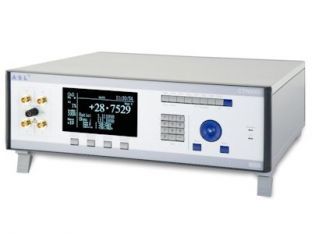CTR6000 (F600DC) - ASL/WIKA
CTR6000 (F600DC) resistance thermometry bridge - ASL/WIKA
The CTR6000 series features a large graphic display, combining versatility with ease of use. As well as the flexible menu options on the display, the CTR6000 also includes buttons dedicated to select common functions. For multichannel applications, the CTR6000 can be used with ASL's existing switch box systems F900 & F18.
Data can be recorded and stored on a PC through the ULog temperature measurement and data acquisition software.
The DC version provides a switched DC sensor current to simulate the advantages of AC measurement. In addition to measuring platinum resistance thermometers (PRTs), the CTR6000 also measures NTC thermistors.
Lees verder
CTR6500 (F650) - ASL/WIKA
CTR6500 (F650) resistance thermometry bridge - ASL/WIKA
The performance of the ASL/WIKA CTR6500 (old article number F650) resistance thermometry bridge is improved significantly by using the proven AC bridge technology. Due to the elimination of thermal EMF errors and the automatic cancellation of probe and cable reactance effects, the CTR6500 provides exceptional stability with time and ambient temperature and has an excellent resolution thanks to inherently low noise.
These make the CTR6500 perfectly suited to high-accuracy temperature measurement and calibration.
The CTR6500 has 25 Ω and 100 Ω internal standard resistors and can also be used with external standard resistors. It has a ratio range of 0 ... 4.9999999 or 0 ... 500 Ω resistance and is capable of measuring temperature ranges to meet ITS 90, CVD and EN 60751 standards.
The results are shown on the large-scale, multi-function VFD screen. The mean, min and max value, standard deviation and the sampling rate can also be displayed with a separate graphical display. To ensure the long-term reliability the CTR6500 uses surface mount technology with no mechanical relays.
Lees verder
CTR9000 (F900 / F18) - ASL/WIKA
CTR9000 (F900 / F18) primary-standard resistance thermometry bridge - ASL/WIKA
In metrology, the most important consideration is the quality of the fundamental measurement. The bridge technology from ASL/WIKA represents the peak of performance in resistance thermometer measurement. It exploits the inherent advantages of AC bridge technology to maintain repeatable measurements of highest precision under practical operating conditions.
The ASL/WIKA CTR9000 (old article number F900 / F18) primary-standard resistance thermometry bridge is designed specifically for resistance thermometry to provide the best possible accuracy.
The 25/30 2) Hz or 75/90 2) Hz operating frequency provides fast, continuous measurement with high immunity to thermal EMF errors and supply frequency noise sources.
Practical measurements involve cables, connectors and imperfect operating environments. The CTR9000 achieves its full specification under a wide range of real operating conditions. AC bridge technology will always outperform measurements made using DC technology with slow current reversal. These benefits are inherent to the fundamentals of electrical measurement and not just the implementation.
2) 60 Hz supply frequency
Lees verder

